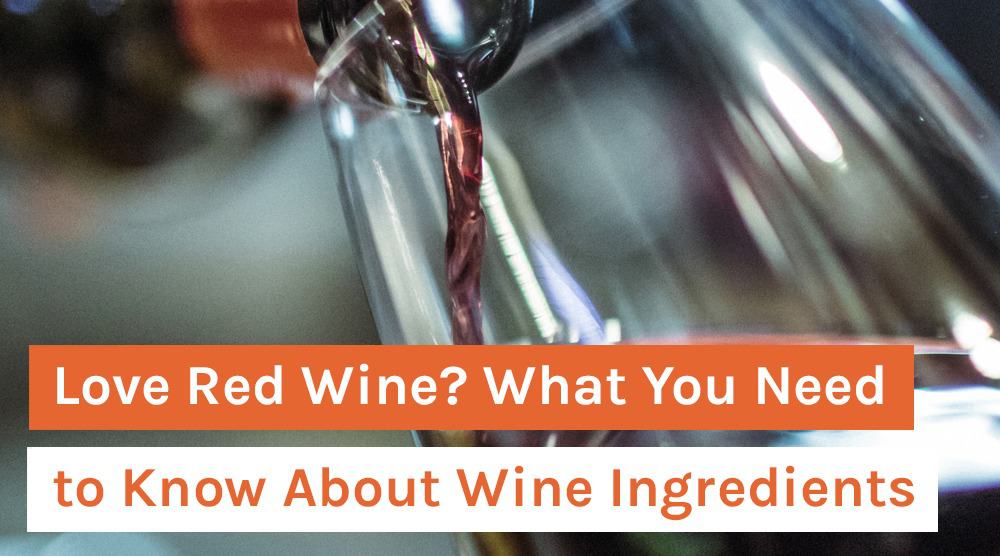Love Red Wine? What You Need to Know About Wine Ingredients
In a hurry? Click here to read the Article Summary...
Are you someone who aims to eat a healthy diet, but also enjoys a glass of red wine one or more times a week? If so, are you aware that there are huge differences in the number of toxins and other health-harming substances between different types and brands of red wine? While just about everyone knows that wine is made with grapes, have you ever considered the other red wine ingredients that go into your favorite vino? Read on for some surprising (and concerning) truths about red wine, and some tips when choosing wine for health.
Red Wine and Health
First off, is drinking red wine healthy for you? According to some researchers, there is evidence that a moderate amount of red wine can be beneficial for your health. The “Copenhagen City Wine Study” conducted in the mid-1990s analyzed data from over 24,000 individuals over a dozen years. The German researchers found that red wine was the only form of alcohol that had a mortality-reducing effect for participants across the board [1].
While the results of this and other studies has contributed to many people drinking red wine “for their health,” it’s important to remember that there are still significant health risks associated with alcohol consumption in general.

For instance, a review study published in 2016 in the journal Addictions reported that there is sufficient evidence to conclude that drinking alcohol directly increases the risk of seven types of cancer (oropharynx, larynx, esophagus, liver, colon, rectum, and breast) [2].
Ultimately, only you can decide whether or not to consume red wine. If you do, we encourage you to spend a little effort in understanding wine ingredients and different processes for producing wine, so you can make the most informed choice for your health.
Lack of Regulation Means Little Wine Ingredient Scrutiny
Have you ever wondered why there is no ingredient list on the wine bottles at the grocery store?
Well, you may say, that is because it’s wine in that bottle. What else could be in there?
The answer is a lot, and not all of it is good. Wine-producing companies are not required by law to disclose what ingredients they put in their bottles. If a wine is over 7% alcohol, it is not regulated by the Food and Drug Administration. Most wines are between 12-15% alcohol.
Because of higher alcohol content, wine, unlike beer, falls under the rules and regulations of the U.S. Alcohol and Tobacco Tax and Trade Bureau (ATTTB) instead. The ATTTB does not require ingredient labeling on the products it monitors [3].
Without public awareness around what is going in their wines, commercial wine manufacturers do what many corporations do these days: create products that appeal to the buying power of the consumer regardless of long-term health effects.
In fact, according to U.S. government standards, the only regulations that wine producers have to adhere to in the U.S. is that they stick to a list of over 50 chemicals that can be added to a bottle for preservation, taste, or shelf life [4].
5 Harmful Wine Additives That Could Be in Your Glass

The reality, however, is that some conventional wines may include dozens of added wine ingredients, including preservatives, dyes, pesticides, added sugar, and added sulfites.
Here are just a few of the “allowed additives” that you could end up consuming along with your “healthy” glass of wine:
- Acetaldehyde. Acetaldehyde is used as a stabilizer. It also helps wine maintain its color. In 1992, the U.S. Environmental Protection Agency (EPA) labeled acetaldehyde as a “probable human carcinogen (group B2) [5].” A 2003 John Hopkins University School of Medicine report linked acetaldehyde toxicity to tumors of the digestive tract [6]. Other research connects it with premature aging [7] and birth defects. Acetaldehyde is also used is in the manufacturing of clothing, soaps, glues, and grouts [8].
- Dimethyl Dicarbonate (DMDC). DMDC is used to inhibit the growth of yeast and also as a sterilizing agent. The U.S. allows the use of DMDC, although the E.U. and some other countries ban it [9]. This is because, in its natural state, DMDC is actually a poison [10]. When it is used to make wine, however, it normally breaks down and turns inert within an hour. The commercial name for DMDC is Velcorin.
- Molds and Mycotoxins. Naturally-occurring molds can sometimes form on vines and wind up in wine, especially those that come from humid areas. The United States does not test for molds. Starting with 2005 vintages, countries within the E.U. do test for certain mycotoxins. One common one is Ochratoxin A (OTA). Exposure to OTA can lead to respiratory inflammation and allergies. A 2010 study published in the journal Toxins also linked OTA to kidney complications and a higher risk for cancer [11].
- Sugar. Believe it or not, most commercial wine producers add extra sugar to their batches in order to up the alcohol content. Wine producers say that this is harmless since the extra sugar is consumed by yeast once the product begins to ferment. Still, the practice of adding sugar to wine batches is illegal in many wine-producing areas, including Argentina, California, and some regions of France. Added sugar in wine should be of concern to those who have insulin sensitivity or are diabetic.
- Sulfites. Sulfites are probably the most noticeably problematic substance in commercial wine for most people [12]. In fact, sulfite sensitivity occurs in roughly 10% of the U.S. population. A report published by the U.S. Department of Agriculture and the University of Florida found that those who suffer from asthma and respiratory infections may have a greater intolerance to sulfites [13]. Symptoms of sulfite sensitivity include headache, rash, gastrointestinal issues, and respiratory reactions [14].
Corked Wine vs Screw Tops: What’s Better for Your Health?
There was a time when to “uncork” was the only way to open a bottle of wine; any sommelier knows the beauty and ritual that goes into this action. Starting in the 1990s screw tops became all the rage, even for higher-end wines.

There exists a whole debate on the advances and disadvantages of screw top versus cork in terms of wine flavor and texture. That is a subject outside the scope of this article. The question that concerns us is one of health and safety. Which is better… screw top or cork. Or does it even matter?
Cork has been used for centuries, of course. Traditionalist say that it allows the wine to breathe and to age over time. The problem with cork nowadays, says naturopathic nutritionist Frank Cooper in a recent article for Natural News, is that for about every 16 or so bottles that you open, one is going to have what is called “cork taint” or “cork rot.” This can give the wine a sour taste and smell.
Cork taint can also be harmful for your health since the musty odor comes from a fungus that is combined with chlorine. This combination eventually becomes a substance called 2,4,6-Trichloroanisole [15].
According to Cooper, who lives and works in the Hunter Valley (one of Australia’s premier wine regions), the chlorine is derived from cork trees that have come into contact with (or been sprayed with) “pesticides such as DDT, chlordane, and heptachlor.” The online database PubChem lists 2,4,6-Trichloroanisole as a fungicide residue that can be an irritant at the very least and warns of “acute toxicity” if swallowed [16]. Needless to say, if you pop a cork and it smells musty, don’t drink the wine.
Screw tops, on the other hand, are typically made from aluminum. On the plus side, there is no chance of cork rot with these tops. And according to experts, screw tops actually allow the manufacturers to add fewer sulfites to the bottle (if they choose to). However, there have also been no studies so far as to whether or not leaching occurs into the wine from the aluminum.
A new cork product developed by French manufactures called Diam is sometimes used. It is made from recycled cork that has been sterilized with carbon dioxide under high pressure. There is less likelihood of cork taint with Diam tops. Needless to say, the jury appears to still be out on all three. Cork, Diam, or screw top, it is up to you!
The Commercial Wine Industry is Dominated by Big Corporations
According to wine sommelier, award-winning podcaster, and author Elizabeth Schneider, about 50% of the wine market in the U.S. is dominated by 10 large wine companies who operate under many different smaller labels [17].

They make their wines in large-scale factories. Similar to any other immense agribusiness enterprises, it is virtually impossible to leave out potentially-harmful pesticides from their mass-produced products. Because they are not obligated to list their ingredients on bottles, there is no way of knowing exactly what’s in them. It’s safe to assume, however, that if it comes from a big commercial producer, the wine ingredient list is loaded with all kinds of extras, including additives, sulfites, extra sugars and, as we shall see, potentially GMOs as well.
Are There GMOs in Wine Grapes and Yeasts?
Sadly, there is the ongoing introduction of genetically modified grapes and yeasts into commercial wine manufacturing. The attraction for vineyard owners and wine manufacturers to GMOs is that it makes crops resistant to pests and can speed up production.
So far, according to the Organic Vineyard Alliance, the countries of Chile, Germany, France, South Africa, and the U.S. have all produced GMO grapes. One of the most well-known in the U.S. is the Chancellor grape, created in the lab to be pesticide-resistant by researchers at the University of Illinois. Amidst an obvious outcry from both consumer groups and organic wine producers, the Chancellor grape has not yet been approved for commercial use [18].
Another element of genetically modified organisms in wine production apparently has been approved for use in Canada, Moldova, and South Africa, along with the U.S. This is the ML01 strain of genetically-modified yeast [19]. Researchers created ML01 to perform two steps in one: the ML01 yeast is able to perform alcoholic and malolactic fermentation (a process to convert malic acid) in a single swoop. According to manufacturers, this also increases the shelf life of the wine.
Again, since commercial wine manufacturers in the U.S. are not obligated to divulge their wine ingredients nor their manufacturing practices, there is always a chance that the wine you are drinking was made with GMO grapes and/or GMO yeast products.

The only way to be sure you’re drinking non-GMO wine, even if it is labeled organic, is to look for the “non-GMO project” verification on the wine label itself.
The Demand for Organic Wine is Growing
As with food products, the organic wine industry is growing as a result of consumer demand. According to a report put out by Yahoo! Lifestyle, European consumers clamor most of all for organic and sulfite-free options. This is why European organic wine operations account for a little over 70% of the growth in that industry. The United States accounts for about 12% and the industry as a whole is expected to rise by 9% by 2022 [20].
According to U.S. Federal Standards, a product can only call itself organic if it has been verified by a third party. This means that wine must be harvested, manufactured, and stored in facilities that are also certified organic as well. The U.S. National Organic Program (NOP) oversees this process in the United States [21].
According to the Organic Vineyard Alliance, wines can also be labeled as “natural.” This means that, although they are not organic, the wine has been created with “nothing added and nothing taken away.” In other words, “natural” wine producers make their product with as little human interference as possible. They do not require a certification to be labeled natural, however.
What About Sulfite-Free or Low-Sulfite Wines?
Experts agree that all wines have to have at least trace amounts of sulfites in them since sulfites develop naturally through the process of fermentation (which is part of winemaking). The same goes for histamines, which can also be a problem for some people. Histamines are amines that are naturally produced during the winemaking process.
The difference is that commercial wine makers often add additional sulfites to their wines. Certified organic wine manufactures, on the other hand, can only add organic additives which are approved by the US. National Organic Program as well as their third-party certifier.
One of the largest certifiers is California Certified Organic Farmers, or CCOF. When organic products and practices are used and nothing else is added to the wine, the wine tends to be naturally low-sulfite and low-histamine in general.
The “Healthiest” Red Wine Option

Biodynamic wines are considered by many to be the crème de la crème of the organic wine world, due to the time, care, and detail that must go into them. Relatively few people have heard about the concept, however, which was first introduced by Austrian-born Rudolph Steiner in the 1920s.
Biodynamic farming in general adheres to the general principles of organic farming and then takes it one step further. It uses specialized fertilizers, water vortexing, astrology, moon cycles, and seasonal growing to vitalize the energetic qualities of the vineyard and the grape.
It may sound strange, but many “converts” to biodynamic gardening say that the difference in terms of purity, taste, and feel is undeniable [22].
Biodynamic wines must be registered by the Demeter Organization so make sure that the biodynamic wine that you want to try out has the Demeter seal on the label.
The challenge is that it’s likely going to be next to impossible to find biodynamic wine at the grocery store or typical wine store in North America. Biodynamic wines tend to be produced by very small vineyards, mostly in Europe. If interested, you may need to talk to a knowledgeable wine importer who can point you in the right direction. (We found an online ordering option here if you’re in the U.S.)
For most consumers, organic wines which are lower in sulfites is likely the healthiest choice that will be available. As mentioned earlier, organic wines are becoming more popular and, as a result, are much easier to find than they were even a few years ago. Asking for organic wine will encourage more restaurants and vendors to provide organic wine options on their menu.
The fact is that humans have been adding substances to wine for centuries. The Romans, for example, used to add lead to their wine to make it thicker [23]. Thank goodness we don’t do that anymore!
Unfortunately, since regulatory bodies are not enforcing health and safety laws as much as they could (or should), it is up to you as a consumer to do your research and know what you’re buying the next time you want to enjoy that glass of red wine.
Want to nourish your body? Organixx OrganiGreens is a revolutionary organic green juice powder made with 14 sprouted & fermented superfoods and botanicals for maximum nutrition.

 Sources:
Sources:
Article Summary
If you’re health conscious and are drink red wine for your health, have you considered the ingredients (other than grapes) that go into a bottle of wine?
Unlike with food, wine-producing companies are not required by law to disclose what ingredients they put in their product.
According to U.S. government standards, the only regulations that wine producers have to adhere to is sticking to a list of over 50 chemicals that can be added to a bottle for preservation, taste, or shelf life
Conventional (i.e., non-organic) wines may include preservatives, dyes, pesticides, added sugar, added sulfites, and GMOs.
The demand for organic wines is growing, especially in Europe. European organic wine operations account for a little over 70% of the growth in that industry while the U.S. accounts for about 12%.
Biodynamic wines can be considered the crème de la crème of the organic wine world because of the time, care, and detail that go into them.
Biodynamic wines can be difficult to find in the U.S. and are mostly imported. For most consumers, organic wines which are lower in sulfites is likely the healthiest choice that will be available.




Hello my friends in Organixx !
Very interesting article . I am so grateful that when God's Kingdom will be operative on this planet that GMO's
will not be allowed anymore. Our Heavenly Father is going to clean out this selfish system and whoever is alive
will not have to struggle the way we do now. There is a lot more I would like to say but I do not want to take your
time.
Thanks again, Erika
Erika you are spot on! We are taught to pray for God's kingdom in the lords prayer and hope to br found worthy of living here on earth to enjoy it.
Pat
DITTO! Great job, Erika! Keep passing the Positive Words, especially during these negative times! Thank-you SO MUCH!
Patty
Your feedback surely made us smile, Erika!
Thank you for sharing your opinions with us regarding this matter, we truly appreciate it.
We hope to see more of you in our future posts!
Can you comment about a specific vintnor?
Fetzer
Hello Grace, thanks for your question.
The challenge is that it’s likely going to be next to impossible to find biodynamic wine at the grocery store or typical wine store in North America. Biodynamic wines tend to be produced by very small vineyards, mostly in Europe. If interested, you may need to talk to a knowledgeable wine importer who can point you in the right direction. We actually found an online ordering option here if you’re in the U.S.: http://www.dryfarmwines.com/organixx.
Hope this helps and enjoy the rest of your day!
Yes, but they don’t ship to about5-7 states, Michigan is one of them! Smart one does though.
That was suppose to be Smartvines
I love dry farm wines. I'd rather spend a little more on them then waste it on the ungrateful.
Erica you may always take my time when it involves
Good heailth and truth and especially anything that we have to wait for our Creator to take care of... when we should be following his directions given already...that being said, if we share his directions and his truths we would only produce the cleanest organically grown products for any consumption by any of our customers
For any reason...we owe it to be as clean and holy in whatever is grown from his earth given to us to use for his glory not ours ...which means ...clean healthy perfection that comes from the perfection he gave us to use ... his creation...his earth and his universe... thanks to the universal sovereign almighty one and only , Father Jehovah God and his son, and our Savior Jesus Christ!!!!!
In addition to all of the wonderful European biodynamic wines, there are lots of bio dynamic winemakers in Oregon and many of them sell online. Brickhouse is one wine maker that comes to mind. Oregon as well known for its Pinot Noir and Chardonnay, all of the Burgundian style wines.
Are there any non-alcoholic brands of wine available that are healthy?
The article on red wines is indicative of why it is so important to take the time to educate ourselves about what we are putting in our bodies. Thank you, once again, Organixx for this article and as far as Dry Farm Wines? Well, I can tell you first hand that I have been a member for over a year and their knowledge of sustainable wine and the ability to have it delivered to our door from across the US and the world is by far a wonderful experience! I would highly recommend them because you will actually drink a bottle from them and see, feel, and enjoy the difference! The way wine should be, I must say! Of course, drink all wine in moderation and with family and friends. Salud'!